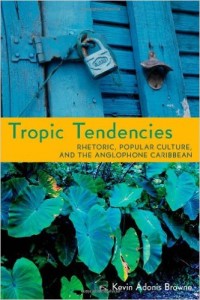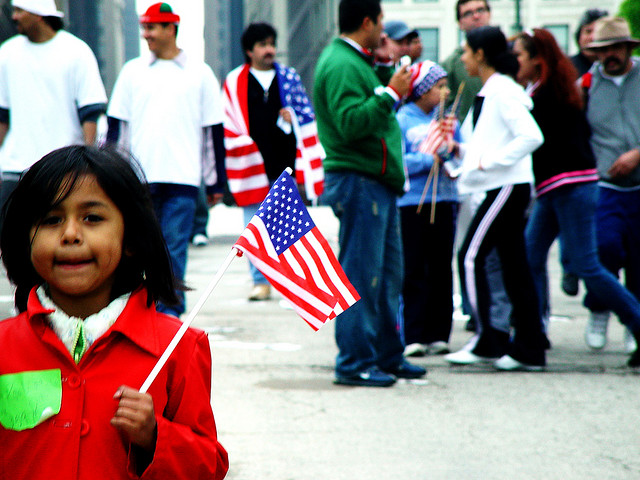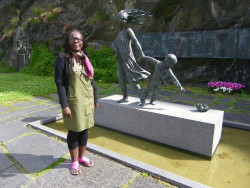Book Review: Browne’s Tropic Tendencies
Browne, Kevin Adonis. Tropic Tendencies: Rhetoric, Popular Culture, and the Anglophone Caribbean. Pittsburgh: U of Pittsburgh P, 2013. Print.
 A Caribbean man in Brooklyn, New York, on a September night attends a Carnival, which is a cultural festivity consistent with the Caribbean tropics. This opening scene of Tropic Tendencies immediately draws the reader into the cultural discourse associated with the Carnival and its importance among Caribbean people. Aware of the contrast this scene projects—a Carnival in New York City—author Kevin Adonis Browne, a native of the Caribbean and a transplant to New York City, brings his insider/outsider perspective to enable readers to see and hear the Caribbean.
A Caribbean man in Brooklyn, New York, on a September night attends a Carnival, which is a cultural festivity consistent with the Caribbean tropics. This opening scene of Tropic Tendencies immediately draws the reader into the cultural discourse associated with the Carnival and its importance among Caribbean people. Aware of the contrast this scene projects—a Carnival in New York City—author Kevin Adonis Browne, a native of the Caribbean and a transplant to New York City, brings his insider/outsider perspective to enable readers to see and hear the Caribbean.
Browne’s thesis is that the Caribbean Carnivalesque is not just a cultural display associated with being Caribbean but that it is a fundamentally rhetorical lens through which they define and express themselves. For Browne, Caribbean cultural identity has inhabited the crisis of intellectual invisibility, dismissed as “Caliban” (echoes of Shakespeare’s The Tempest, also a colonial subtext). Browne aims to make this rhetoric visible and audible by posing the following question: What is Caribbean rhetoric? The answer, which forms the bulk of the book, is couched in teleological goals: namely,
- to exercise judgment,
- to seek critical redress for calcified historical injustices,
- to express a desire for recognition—to be seen and heard—and/or
- to solidify the essence of Caribbeanese through its artifacts and symbols.
Using what he calls the “Caribbean Carnivalseque” as a rhetorical trope that defines the essence of being Caribbean, Browne grounds his analysis in Kenneth Burke’s Rhetoric of Motives and the concept of human beings as symbol-using animals. Those symbols—identifiably Caribbean and emblematic of the Caribbean experience—center on the Carnival and associated accouterments, namely masque, performance, and vernacular language. Browne acknowledges that speaking for the Caribbean, given its geographic territory, is inherently problematic because of its geographic size and heterogeneous populace. And yet he manages to forge a collective identity among those who identify as Caribbean by capturing their shared fear of marginalization.
In chapter 1, Browne explores the place of the Caribbean in global trade. This historical accounting discusses the role of industrialization in “smoothing out the relationships” between the black labor force and the plantations and how it led to modernized export systems and constructing the Panama Canal (11). This discussion helps to contextualize the emergence of the Caribbean and its fraught relationship with colonialism. As part of this capitalistic global trade, for example, audiences with a colonial mindset consumed the Carnival as mere spectacle because it was a fusion of cultures—European, African, Indo-Chinese—that together birthed what we call the Caribbean, implying that the Carnival does not belong to any one group. Browne indicates that the Carnival has had to fend off attempts to be co-opted by conquering powers ranging in succession from the Italian to the British and, now, cosmopolitanism. These attempts to render the Carnival a myth both depersonalize and strip it of its cultural identity.
Naturally, the Caribbean people resent this sidelining and consider it an affront to their identity. To them, the Carnival belongs to a dispossessed people. It is an individual and collective practice through which they engage in “rhetorical display” (11) to resist subjugation, register their presence, and articulate their voices. The Carnival not only embodies a critical form of rhetoric as a means of constructing argument, it is also emancipatory. Further, inasmuch as it reflects collective and experiential knowledge, it is a stand against the tyranny of colonialism and its enduring legacy of dispossession.
Having established that understanding, Browne intimates that the Carnival will not be silenced. It must be seen; it must be heard—for it reclaims agency. It is also the means through which a people constitute their own communicative needs and desires. In this pursuit, the Carnival is infused with language, style, and meaning and can be both revelry and revolt, depending on what angle the onlooker takes. Carnival is a visceral statement proclaiming, “This is who we are!” It’s both epideictic and epistemic in significance (13).
Chapter 2 focuses on the Caribbean language. Through a close reading of Kenneth Burke’s symbolism, Browne attempts a pentadic application to Caribbean voice’s “expressive features and situations” (31) and finds that the Caribbean language resists pentadic analysis. For while this focus on language traces the origins of Caribbean voice to its English roots, that’s where the similarity ends. Caribbean voice, or as he calls it, vernacular, distinguishes itself from Standard English in “intonation, nasalization, and semantics” (32). These syntactical features are as much an assertion of self as they are a (new) language that’s identifiably Caribbean.
Readers familiar with African American rhetoric will see similarities in the performative aspects of Caribbean language and how it engages techniques such as code-switching and wordplay as tools of inclusion and exclusion. Because Caribbean language inhabits the spectrum between “bad” and Standard English, ushering in a “language ambivalence” (35), it signals a separation of the sophisticated from the foolish and simpleminded. As a result, creolization has attracted among other sentiments scorn and ridicule and had its legitimacy questioned, leading to renowned Caribbean writer Braithwaite’s wish for a “nation language” that still reflects its English origins and, with it (presumably), communicative competence.
Browne wants his academic readers to know that the Caribbean language is neither linguistically inferior nor deficient. Examined for its rhetorical goals, Caribbean language demonstrates rhetorical forms of argumentation including epideictic performance, instruction, critique, resistance, and avoidance. These forms of argumentation are often accompanied by nonverbal semantics that are both material and tactile.
There is a lot of Derrida’s Structure Sign and Play in chapter 2 when Browne pivots to an analysis of visual vernacular images, suggesting that these images speak for the otherwise voiceless marginalized. And yet these visuals are not particularly self-evident. Most are photos taken by Browne and interpreted by him for the reader. It’s not clear that other Caribbean language speakers would similarly interpret them as Browne does given his rhetorical framing and of course his personal familiarity with, for example, his great uncle’s house. As a result of the insider/outsider knowledge, which can be construed as subjective (Browne acknowledges as much on page 77), this question lingers in the academic reader’s mind; nevertheless, Browne wants his readers to know that vernacular visual events are a means to communicate sometimes temporal, and other times contextual, knowledge. They may symbolize acceptance, critique, or aspiration (72) and so are worth examining. Further, they complement otherwise abstract forms of meaning rendered linguistically and evoke a visceral interpretation operating as they are at a heightened sense of ethos.
In chapter 3 we follow the schism from language to music, which we learn is about the collective knowledge of the Caribbean people; however, its invention, arrangement, delivery, and performance (from Aristotle’s canons of rhetoric) are left to the individual performer and the Caribbean people familiar with its soul as primary audience. Using the proverb “who don’t hear will feel” (81), Browne suggests that successful rhetorical performers combine “verbal and visceral persuasive iteration” (82) to be heard, so as to spare people from “feeling,” presumably, pain.
Browne underscores the idea that while access to Caribbean language is restricted to Caribbean speakers and those otherwise familiar with its collective knowledge, by contrast, Caribbean music is widely, even globally, versatile. Through features like sound, silence, and symbol, Browne sees Caribbean music as not just a form of resistance, but also a means of escape both metaphorically and literally from the shackles of geographic and physical confinement.
Take the most recognized form of Caribbean music, the calypso. Browne’s retelling of calypso’s evolution from the “chantwell, in whose power was language” (83; and is delivered by a wise man who chants well, also reminiscent of the Sophists) was, I found, most revelatory. Chantwell itself expresses communal wisdom, knowledge and the divine delivered in the form of a Calenda, which traces its roots from Yoruba (a west African language) to French creole, English, and now vernacular. This critical history helps explain the structure and form of the calypso. Calypso embodies “vernacular epideictic sensibilities” (83), creates a form of resistance, and keeps memory for posterity. Readers will be interested to learn that it is from the chantwell that the calypso originated, revolutionized by events surrounding political agitation from the 1960s to the 80s in the Caribbean, crossing over to the Americas (consider Harry Belafonte’s overtly political music). As performers bridge public-private spaces, the calypso evolves from a tool for castigating the powerful to a self-critical introspection delivered in the form of a jeremiad.
In chapter 4, “We is People,” Browne examines the rhetoric of vernacular fiction as utilitarian rather than for enjoyment. Fiction, he intimates, should serve the dual purpose of reflecting Caribbean consciousness and reinforcing pride in its people and disabuse those who are dismissive of it as amusement—a goal he himself hews closely to. To illustrate this dual goal, Browne focuses on Caribbean writer Earl Lovelace’s deployment of ethos as “a form of self-discovery” (109) emergent from material conditions as an invocation against an emasculating world. This vernacular ethos draws from the indignities of history to project a liberated self—in spite of or informed by that history (125-26). In advancing this narrative, however, Browne overlooks the social forces that together form the Caribbean. The congregating of people who otherwise inhabit different social spheres no doubt brings with it new ideas and intellectual exchanges resulting in cultural transformation. In time, such transformation should in turn produce literature, art, music, and dance for its own sake—even if it be for amusement.
When we get to chapter 5, “Digital Vernacular,” we realize that Browne has cleverly spanned all the communicative elements of the Caribbean including performance, orality, music, print, and, finally, the digital world of social networking, blogging, and multimedia representation. Every one of those genres is infused with Caribbean presence—perhaps sidelined but present nevertheless. Because he has been careful to embody the Caribbean people with these aspects, Browne is aware that he needs to thread this needle carefully when it comes to the digital virtual world. Can digital technology accurately represent the Carnival? Further, given Caribbean resistance to adaptation, how do Caribbeans maintain their authentic selves in this virtual world? Enter Cariblogging, a blogging practice by Caribbeans.
In this chapter, Browne finds that social networking platforms make communicating in vernacular possible. This finding corroborates research by Beth Kanter and Allison Fine, which holds that individuals perceive a “conversational human voice” (62) more from blog content because it encourages a colloquial voice and can be used to develop meaningful relationships with bloggers’ publics (see also André Brock on Black Twitter). Caribloggers display “a vernacularized awareness of technology” (130) by employing visual displays in digital media videos, known as “jamette” (149-50), that can project Carnivalesque ethos proclaiming “Caribbeans will be seen and heard!” Likening the blogger to the masquerade whose performance is not overtly tailored to an audience, Browne concludes that there is nevertheless an implicit anticipation of the need for validation by the readers whose role it is to judge the success or failure of the performance. Readers’ affirmation in fact helps sustain the discourse, without which, the blogger may peter out and die.
I commend Browne for his willingness to tackle the social and cultural shifts prompted by colonial histories, the diaspora, and a growing digital landscape to help articulate the rhetorics of a people, especially when paired with his clever resistance to modernity, a shared diaspora sentiment. That sentiment, which enables him to look in from the outside as a diaspora citizen, helps keep a constant aspect of the Caribbean as an object of study. But with the rapidly changing ways of the Caribbean, it is also his weakness in analyzing the rhetoric of the region. Scholars wanting to debate Caribbean rhetoric might wonder if the region is indeed trapped by that legacy given the writer’s inability to move beyond self-assertion.
Browne’s contribution is a welcome addition to rhetorical scholarship, which has expanded to instruction in various rhetorics. Given the increased climate of globalization, students need the opportunity to learn concrete strategies for communicating with and understanding others around the globe. And, in Tropic Tendencies, with the Carnivalesque form as content, they have an opening salvo. Before it can set the terms for its own debate, Tropic Tendencies, as a single work, must work closely with the rhetorical tradition to be recognizable as rhetoric; at the same time, the work attempts to maintain autonomy from the rhetorical tradition to be studied seriously. That’s a delicate balance that cannot be achieved in one fell swoop.
Works Cited
- Browne, Kevin Adonis. Tropic Tendencies: Rhetoric, Popular Culture, and the Anglophone Caribbean. Pittsburgh: U of Pittsburgh P, 2013. Print.
- Kanter, Beth, and Allison Fine. The Networked Nonprofit: Connecting with Social Media to Drive Change. San Francisco, CA: Wiley, 2010. Amazon. Web. 10 Apr. 2015.




 Josephine Walwema teaches writing and rhetoric at Oakland University. Her teaching focus in on business, professional and legal writing. Her writing has appeared in Writing and Pedagogy, Technical Communication, and Programmatic Perspectives.
Josephine Walwema teaches writing and rhetoric at Oakland University. Her teaching focus in on business, professional and legal writing. Her writing has appeared in Writing and Pedagogy, Technical Communication, and Programmatic Perspectives.